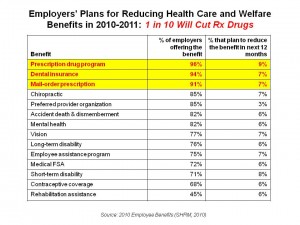 As the recession continues to negatively impact U.S. business, employers are tightly managing benefits across-the-line, from health to housing and travel categories. Benefits overall are experiencing a downward trend versus 5 years ago.
As the recession continues to negatively impact U.S. business, employers are tightly managing benefits across-the-line, from health to housing and travel categories. Benefits overall are experiencing a downward trend versus 5 years ago.
In the health arena, benefits that show staying power include wellness resources (covered by 75% of employers), on-site flu vaccinations (68%), wellness programs (59%), and 24-hour nurse lines (59%). On the downside, benefit programs that are expected to erode in the next 12 months are prescription drug coverage, dental insurance mail-order drug programs, and chiropractic coverage, among others shown in the chart.
The Society for Human Resource Management (SHRM) has polled 279 benefits managers in February 2010 and published results in the report, Employee Benefits in a Post-Recession Economy.
Health Populi’s Hot Points: Keeping employees well, and fending off illness and disability, is the post-recession health benefits ethos for U.S. business. Newer wellness services emerging among employers in 2009-2010 include rewards and bonuses for completing programs, nutrition counseling, and health and lifestyle coaching.
Consider this employers migrating toward “health” and moving resources away from “health care.”
On another front, it’s useful to look underneath the health benefits hood to understand the variance of health benefits by employer size and type. Of prime importance in the recession (or post-recession) economy is the individual firms’ revenue-per-employee, which is one way to measure productivity. SHRM found that companies with greater revenue per employee (as FTE) spend more on health care benefits than companies with lower RPE per FTE in 2009. When RPE is over $155,556, a company spends $8,068 on health care. When a company’s RPE/FTE is lower than $155,556, they spend an average of $5,629 on health care.
Companies in service businesses, from retail to travel and hospitality, tend to have lower RPE’s than those in technology and high-end manufacturing. This begs the question: where is the new job creation? In companies with greater RPE/FTEs? How this job creation story plays out will portend what the employer health benefits story will look like in the coming years.




 Thanks to Feedspot for naming this blog, Health Populi, as a
Thanks to Feedspot for naming this blog, Health Populi, as a